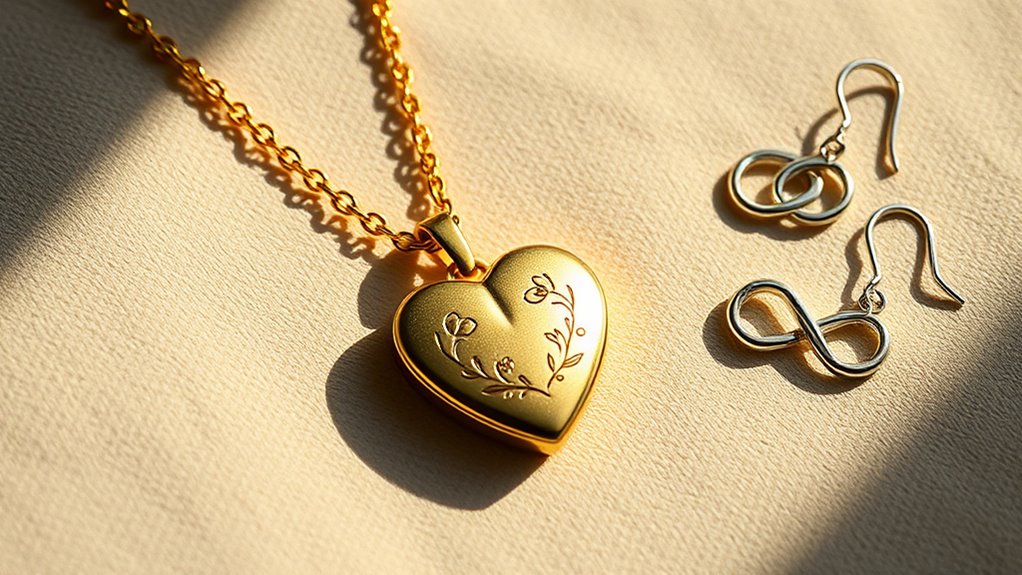Jewelry often serves as a language of symbols that express your beliefs, heritage, and milestones. Different pieces like birthstones, religious pendants, or cultural motifs carry unique meanings, representing personality traits, spiritual beliefs, or social status. Wearing these pieces helps communicate who you are and what you value without words. Each symbol adds depth and personal significance to your jewelry collection — uncover more to discover the stories behind these meaningful adornments.
Key Takeaways
- Jewelry often carries cultural, spiritual, or personal symbols that convey identity, beliefs, and values.
- Birthstones represent specific months and symbolize personality traits, luck, or milestones.
- Certain jewelry pieces, like wedding rings or talismans, symbolize commitment, protection, or spiritual significance.
- Cultural jewelry items reflect traditions, social status, and rites of passage across different societies.
- Understanding jewelry symbolism enhances personal expression and connects wearers to their heritage or life stories.

Jewelry has long served as more than just adornment; it’s a powerful way to express your beliefs, values, and identity. When you choose a piece of jewelry, you’re not only selecting something beautiful but also something meaningful. For example, birthstone significance plays a vital role in personal jewelry choices. Each birthstone is associated with a specific month and carries symbolic meanings that can reflect your personality, aspirations, or even bring luck and protection. Wearing your birthstone can serve as a personal talisman, connecting you to your identity and heritage. Beyond individual significance, birthstones can also symbolize milestones, such as anniversaries or achievements, making jewelry a living record of your life’s journey.
Cultural jewelry meanings deepen this connection further. Different cultures assign unique symbolism and significance to various jewelry pieces, shaping how they’re worn and understood. In some traditions, jewelry isn’t just decorative; it’s a symbol of social status, spiritual beliefs, or rites of passage. For instance, in Indian culture, jewelry like mangalsutra or nose rings isn’t merely ornamental but deeply rooted in cultural rituals and religious symbolism. These pieces often signify marital status or cultural identity. Similarly, in African societies, certain beads and charms carry protective or spiritual meanings, serving as amulets or symbols of community and heritage. Understanding these cultural jewelry meanings helps you appreciate the depth behind each piece, recognizing that jewelry often tells stories passed down through generations.
When you wear jewelry with cultural or personal significance, you’re embracing a form of non-verbal communication. It’s a way to honor your roots or showcase your beliefs without saying a word. For example, a pendant featuring a symbol from your cultural heritage speaks volumes about your identity and respect for traditions. Likewise, choosing jewelry based on birthstone significance can be a way to carry a piece of your history or personal connection with you every day. These meanings enhance the value of your jewelry, transforming it from mere decoration into a meaningful artifact that resonates with your life story. Additionally, understanding the symbolism behind popular jewelry pieces allows you to select items that truly align with your personal narrative and values.
In essence, understanding the symbolism behind jewelry—whether it’s through birthstone significance or cultural jewelry meanings—enriches your appreciation for each piece. It allows you to wear jewelry with intention, making your adornments more than just accessories. They become expressions of who you are, where you come from, and what you hold dear. This awareness turns jewelry into a powerful form of personal storytelling, connecting you to a larger tradition of meaning and symbolism that spans cultures and generations.
Frequently Asked Questions
How Do Cultural Differences Influence Jewelry Symbolism?
Cultural differences considerably influence jewelry symbolism, as you’ll find that regional traditions and customs shape what certain pieces represent. For instance, in some cultures, specific colors or materials symbolize status, spirituality, or protection. You might notice that a necklace or ring holds different meanings depending on where you are, reflecting local beliefs and values. Recognizing these cultural nuances helps you appreciate jewelry’s deeper significance across diverse societies.
Can Jewelry Symbolism Change Over Time?
Did you know jewelry symbolism has evolved considerably over centuries? Yes, it can change as designs evolve and cultural meanings shift. You might notice a necklace once representing wealth now symbolizes friendship or empowerment. These shifts reflect societal changes, personal growth, and new interpretations. So, as you wear jewelry, remember its meaning isn’t fixed; it’s a dynamic story that adapts with time and cultural influences.
Are There Universal Meanings for Specific Jewelry Pieces?
You’ll find that some jewelry pieces have universal meanings, like a wedding ring symbolizing commitment or a locket representing cherished memories. However, personal significance often varies based on individual experiences. While fashion trends influence how you wear jewelry, the core symbolism remains consistent across cultures. Remember, the meaning behind a piece can evolve with your personal story, making jewelry both a universal and deeply personal expression.
How Do Personal Experiences Affect Jewelry Symbolism?
Your personal memories deeply influence jewelry symbolism by adding emotional significance to each piece. When you wear jewelry linked to special moments or loved ones, it becomes more than decoration; it’s a reminder of those experiences. These personal connections make the jewelry uniquely meaningful, often representing love, achievement, or remembrance. Your individual history shapes how you interpret and cherish jewelry, turning it into a powerful symbol of your life’s journey.
What Are Some Rare or Hidden Jewelry Symbols?
You might come across rare or hidden jewelry symbols like secret motifs or discreet engravings that convey personal messages or beliefs. These hidden motifs could include coded symbols, tiny gemstones, or subtle carvings, serving as secret symbols only you or a chosen few understand. Such pieces allow for discreet self-expression or meaningful connection, making your jewelry uniquely personal and layered with hidden meanings that go beyond their outward appearance.
Conclusion
Now that you understand the symbolism behind common jewelry pieces, you can wear them with meaning and intention. Whether it’s a locket as your “lucky charm” or a ring symbolizing love, each piece tells a story. Remember, jewelry has been conveying messages for centuries—think of it as your own personal Morse code. So, next time you slip on that necklace or bracelet, you’re not just accessorizing; you’re carrying a piece of history and emotion with you.








